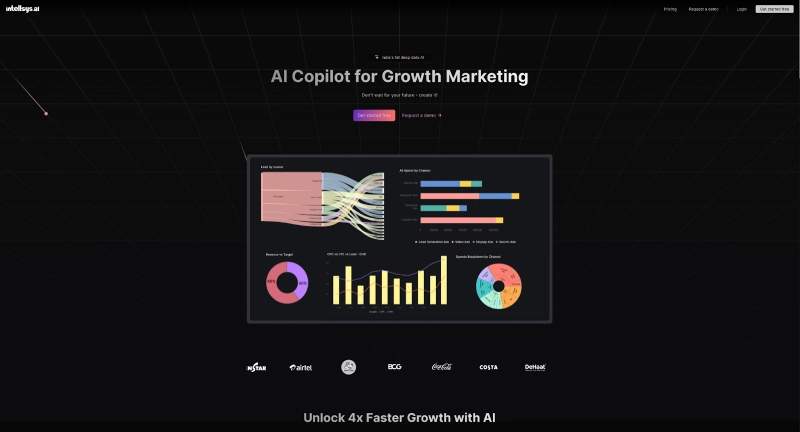Actionable Insights for Marketers: Why Intellsys Stands Out

Marketers don’t have a data problem. They have a “what the hell do we do with all this?” problem. With campaigns running across CRMs, ad platforms, emails, and socials, it’s easy to feel like you're swimming in numbers but sinking in confusion.
43% of CMOs[1] say their teams spend more time wrangling data than using it to make decisions, and honestly, that tracks.
This is where your data management platform should save the day. But most tools? They just dump everything into a dashboard and wish you luck.
Intellsys flips the script. Built by GrowthJockey, it’s a next-gen data management system that shows you what happened and what to do next. Real-time signals. Predictive nudges. Decisions that actually impact your growth.
In this blog, we’ll dig into the hidden cost of messy data, how Intellsys compares, and how to put it to work in your own setup.
The hidden costs of poor data management in marketing
Before we get into what makes Intellsys different, let’s talk about what most marketing teams are up against and why even the best tools can leave you stuck if they don’t give you actual answers.
Here’s what inadequate data management systems are costing your team every single week:
-
Data fragmentation syndrome: The average marketer juggles data from social media, email campaigns, and website analytics, but lacks a unified view. This fragmentation leads to missed optimisation opportunities and conflicting strategic directions.
-
Analysis paralysis: Across most teams, hours are sunk into downloading, cleaning, and piecing together data from different sources. Instead of working on strategy, marketers end up stuck in spreadsheets. Of course, this is inefficient, but it’s also demotivating for high-skill marketers who want to focus on creatives, not cleanup.
-
Decision delay costs: Without real-time input from your data management tools, campaigns keep bleeding money while you wait for the monthly report to land. In many cases, teams end up spending 60–75% more on customer acquisition[2] simply because they couldn’t pivot fast enough.
-
Manual reporting burns 20+ hours per week: Across large teams, reporting without automation takes up days of collective effort. That’s time that could’ve gone into testing new channels, refining messaging, or improving conversions.
The cost of all this? Potentially thousands in wasted spend and lost customer acquisition opportunities.
Why Intellsys is built to fix what most data management platforms get wrong

Now that we've unpacked the real cost of disconnected systems and bloated reporting loops, it’s clear: most data management platforms are built to collect data, not to make it useful.
And that’s the problem. You don’t need another tool showing you what happened. You need one that tells you what to do next.
Intellsys- Growth marketing platform was designed to close the gap between raw data and fast, effective decisions. Here’s how it solves the biggest challenges marketers face today:
-
Unifies fragmented data into a single source of truth: Intellsys brings together data from 200+ tools like CRM, ads, email, product analytics and cleans it using AI to remove duplicates, errors, and inconsistencies. This leads to a complete, real-time view of your marketing performance in one dashboard. No more switching tabs or second-guessing numbers.
-
Delivers predictive, not reactive, recommendations: At the core of Intellsys is Copilot AI, a game-changing intelligence engine developed by harnessing the expertise of the top 1% of global digital experts. Unlike basic automation, Copilot learns from successful marketing patterns and provides contextual recommendations tailored to your specific business model and industry.
-
Enables real-time decisions that save budget: When campaign performance dips, Intellsys doesn't wait. It can consolidate data from 200-plus complex, siloed data sources while analysing over 1.5 crore data points every second. Its real-time decision engine pushes alerts or triggers actions like pausing spend, shifting budget, or notifying your team before waste piles up. That’s how teams cut acquisition costs and recover ROAS quickly.
-
Eliminates hours of manual reporting: With smart templates, drag-and-drop dashboards, and automated insights, Intellsys replaces the weekly reporting grind with instant visibility. Whether you need a C-suite snapshot or a granular channel breakdown, the right report is always ready to go.
-
Outcome-focused metrics: Rather than overwhelming users with vanity metrics, Intellsys prioritises actionable KPIs tied directly to business outcomes. The platform automatically highlights the metrics that matter most for your specific goals and growth stage.
-
Taps into shared intelligence, not just your own: Through its Community Intelligence layer, Intellsys learns from a network of high-performing campaigns across industries. This community-driven approach means your platform benefits from proven strategies and emerging best practices without requiring extensive internal experimentation.
Here’s a quick side-by-side comparison to make the obvious choice even easier:
| Feature/capability | Typical data management software | Intellsys |
|---|---|---|
| Data integration | Limited integrations, often manual | Connects to 200+ tools with AI-powered cleaning |
| Insight delivery | Shows what happened | Tells you what to do next via Copilot AI |
| Decision speed | Weekly/monthly lag in reporting | Real-time alerts and auto-triggered actions |
| Reporting workflow | Manual data pulls, spreadsheet work | Drag-and-drop dashboards, instant snapshots |
| Focus metrics | Vanity metrics (CTR, impressions) | Business-linked KPIs (ROI, CAC, revenue impact) |
| User experience | Built for analysts, not marketers | Intuitive UI designed for fast, everyday use |
| Intelligence source | Based on internal data only | Learns from high-performing campaigns across industries |
| Team efficiency | Teams spend 20+ hrs/week on reporting | Saves hours with automation and clarity |
Put simply, most data management software gives you more dashboards. Intellsys gives you answers.
Proven results: How Intellsys users achieve measurable marketing success
The true test of any marketing intelligence platform is measurable business impact. Intellsys users consistently report significant improvements across key marketing metrics:
-
33% average reduction in customer acquisition cost (CAC): By streamlining audience segmentation and optimising ad spend, Intellsys helps brands attract new customers at a lower cost. Smarter allocation and faster decisions lead to leaner acquisition models.
-
39% improvement in audience targeting: Intellsys uses AI to analyse demographics, interests, behaviours, and past interactions, then builds actionable personas for precise segmentation. Now, they are tighter, and campaigns land where they’re supposed to.
-
70% increase in conversion rates: Predictive recommendations and churn signals let marketers personalise outreach and tailor offers at the exact moment they’re needed. This kind of insight turns browsers into buyers.
-
55% lift in click-through rates (CTR): Intellsys optimises campaign content in real time, ensuring every ad, email, or message is more relevant and engaging. Better timing + better targeting = better results.
-
78% faster ad performance and optimisation cycles: With automation baked into the system, marketers can launch, test, and scale campaigns faster. No more bottlenecks or bloated workflows; just agility and results.
These aren’t isolated wins. They reflect what’s possible when a data management service is built for speed, clarity, and decision-making.
Just ask SleepyHug.
The D2C sleep brand didn’t scale to ₹100 Cr ARR in 13 months by accident. It grew with intention and was powered by real-time dashboards, automated insights, and full-funnel alignment driven by Intellsys.
Marketing, product, and operations worked off a shared view of performance. CAC was tightly controlled. LTV was improved with targeted retention and re-engagement flows. Nothing was left to guesswork.
From pricing tweaks to influencer spends to supply chain efficiency, SleepyHug made faster, sharper decisions because its systems were built to support them. This exact clarity helped the brand stay profitable while scaling, without burning through budget or relying on guesswork.
That's what happens when your data is built into the way you grow.
What real users are saying about Intellsys
The numbers speak for themselves, but so do the teams behind them. Here’s what marketers and growth leads have said after switching to Intellsys:
⭐⭐⭐⭐⭐
“Amazing product, I was spending a lot of time in making dashboards for my product's marketing data, and this tool made the process of creating dashboards very easy making. Give this is a chance if you're also facing issues with dashboard analytics and data visualisation.”
– Geet Potnuru
⭐⭐⭐⭐⭐
“This tool is a game-changer for businesses looking to make decisions backed by real data. With seamless Integration to various data sources, it automatically generates insightful reports, making complex analysis accessible to everyone.”
– Lakshita Vyas
Getting started with a data management platform like Intellsys
Rolling out a new data management platform can feel overwhelming, especially when you’re juggling campaigns, reports, and team bandwidth. But it doesn’t have to be. With the right approach, platforms like Intellsys can be set up quickly, without derailing your day-to-day.
Let’s take a look at how teams are making the transition smooth and impactful:
-
Start with the right questions: Before you even touch the platform, get clear on what you want to improve. Are you trying to cut CAC, clean up reporting, or scale campaigns faster? Your goals will shape how you configure the platform from day one.
-
Plug in the highest-impact tools first: Intellsys connects with 250+ tools, but you don’t need to use them all right away. Begin with the big ones, such as your CRM, ad platforms, and email tools and build from there. These are the sources your data management system should prioritise.
-
Establish baseline metrics: Track current performance across key metrics before you switch. That way, you can clearly show the impact once your data management system is live, especially to stakeholders who care about ROI.
-
Define how insights become actions: Decide who gets alerts, what triggers optimisations, and how quickly your team is expected to respond. This makes your workflow feel seamless, not reactive.
-
Invest in team confidence: The best data management tools don’t require a data science degree, but a little onboarding goes a long way. Run short trainings, document workflows, and keep support accessible.
Once it’s up and running, Intellsys doesn’t feel like a new system. It just becomes part of how things get done.
Evolving your data management system for what’s coming next
Real-time decisions are the new norm. Monthly reports? That’s already feeling outdated for teams who want to stay ahead.
Tomorrow’s data management platforms won’t just show you what happened last week. They’ll help you predict which campaign’s about to flop, where budget will be wasted, and what your highest-value customers are likely to do next.
Don’t worry, this doesn't mean handing the reins to AI. It means combining smart tech with sharper human judgment. The best data management tools will do the heavy lifting, like sorting signals from noise, so your team can focus on what actually drives growth.
The good news? You don’t have to wait for “the future” to get there.
Intellsys, built by GrowthJockey, brings that kind of speed and clarity into your workflow today. No more duct-taping dashboards together. No more 3-day reporting delays. Just one place to track performance, spot opportunities, and act on them, fast.
If you're ready to cut through the clutter and turn data into something useful, start your free trial of Intellsys and see how it fits into your team.
FAQs on data management platforms
What are the four types of data management?
While data management covers a broad range of practices, it’s often grouped into four core types:
-
Data Storage – Where and how data is physically kept (e.g. databases, data lakes, cloud storage).
-
Data Integration – Combining data from multiple sources into a unified view (ETL processes, APIs).
-
Data Governance – Managing data quality, privacy, security, and compliance.
-
Data Analytics – Using tools and platforms to interpret, visualise, and act on the data.
Together, these form the backbone of any strong data management platform or strategy.
What is DMP vs CDP?
DMP (Data Management Platform) is primarily used in advertising. It collects anonymous user data (like cookies, IP addresses) to help with audience targeting, especially in programmatic ad buying. It’s great for third-party data and short-term insights.
While CDP (Customer Data Platform) focuses on first-party data, it includes real customer interactions like email, purchases, and website activity. It builds unified customer profiles and is often used for personalised marketing across channels.
What are examples of data management platforms?
One modern example of a full-stack data management platform is Intellsys by GrowthJockey. It’s built not just to store and organise marketing data, but to turn that data into real-time insights you can act on.
With features like predictive analytics, automated reporting, and integrations with 250+ tools, Intellsys supports everything from campaign optimisation to cross-channel attribution, all in one place.
Is SQL a data management system?
Not quite, but it’s an essential part of one.
SQL (Structured Query Language) is a language used to manage and query relational databases. It’s the tool you use within a data management system (like MySQL, PostgreSQL, or Microsoft SQL Server) to store, retrieve, update, and manage data.
So while SQL itself isn’t a full data management platform, it’s a key technology that powers many of them.








